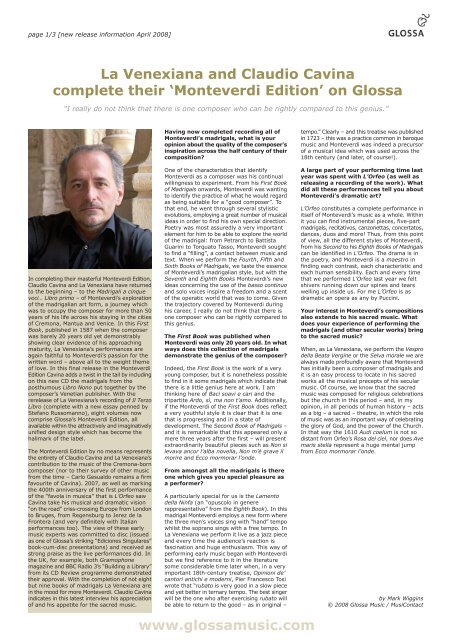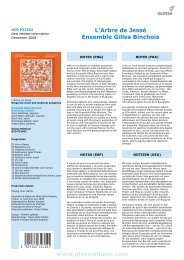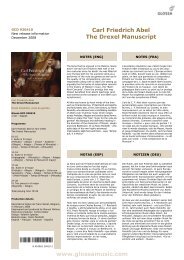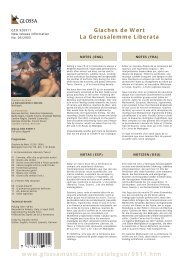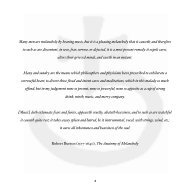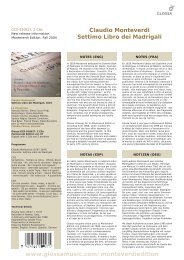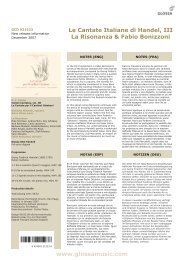Commercial release sheet (PDF) - Glossa Music
Commercial release sheet (PDF) - Glossa Music
Commercial release sheet (PDF) - Glossa Music
You also want an ePaper? Increase the reach of your titles
YUMPU automatically turns print PDFs into web optimized ePapers that Google loves.
page 1/3 [new <strong>release</strong> information April 2008]<br />
La Venexiana and Claudio Cavina<br />
complete their ‘Monteverdi Edition’ on <strong>Glossa</strong><br />
“I really do not think that there is one composer who can be rightly compared to this genius.”<br />
In completing their masterful Monteverdi Edition,<br />
Claudio Cavina and La Venexiana have returned<br />
to the beginning – to the Madrigali a cinque<br />
voci… Libro primo – of Monteverdi’s exploration<br />
of the madrigalian art form, a journey which<br />
was to occupy the composer for more than 50<br />
years of his life across his staying in the cities<br />
of Cremona, Mantua and Venice. In this First<br />
Book, published in 1587 when the composer<br />
was barely 20 years old yet demonstrably<br />
showing clear evidence of his approaching<br />
maturity, La Venexiana’s performances are<br />
again faithful to Monteverdi’s passion for the<br />
written word – above all to the weight theme<br />
of love. In this final <strong>release</strong> in the Monteverdi<br />
Edition Cavina adds a twist in the tail by including<br />
on this new CD the madrigals from the<br />
posthumous Libro Nono put together by the<br />
composer’s Venetian publisher. With the<br />
re<strong>release</strong> of La Venexiana’s recording of Il Terzo<br />
Libro (complete with a new essay penned by<br />
Stefano Russomanno), eight volumes now<br />
comprise <strong>Glossa</strong>’s Monteverdi Edition, all<br />
available within the attractively and imaginatively<br />
unified design style which has become the<br />
hallmark of the label.<br />
The Monteverdi Edition by no means represents<br />
the entirety of Claudio Cavina and La Venexiana’s<br />
contribution to the music of the Cremona-born<br />
composer (nor to their survey of other music<br />
from the time – Carlo Gesualdo remains a firm<br />
favourite of Cavina). 2007, as well as marking<br />
the 400th anniversary of the first performance<br />
of the “favola in musica” that is L’Orfeo saw<br />
Cavina take his musical and dramatic vision<br />
“on the road” criss-crossing Europe from London<br />
to Bruges, from Regensburg to Jerez de la<br />
Frontera (and very definitely with Italian<br />
performances too). The view of these early<br />
music experts was committed to disc (issued<br />
as one of <strong>Glossa</strong>’s striking “Ediciones Singulares”<br />
book-cum-disc presentations) and received as<br />
strong praise as the live performances did. In<br />
the UK, for example, both Gramophone<br />
magazine and BBC Radio 3’s “Building a Library”<br />
from its CD Review programme demonstrated<br />
their approval. With the completion of not eight<br />
but nine books of madrigals La Venexiana are<br />
in the mood for more Monteverdi. Claudio Cavina<br />
indicates in this latest interview his appreciation<br />
of and his appetite for the sacred music.<br />
Having now completed recording all of<br />
Monteverdi’s madrigals, what is your<br />
opinion about the quality of the composer’s<br />
inspiration across the half century of their<br />
composition?<br />
One of the characteristics that identify<br />
Monteverdi as a composer was his continual<br />
willingness to experiment. From his First Book<br />
of Madrigals onwards, Monteverdi was wanting<br />
to identify the practice of what he would regard<br />
as being suitable for a “good composer”. To<br />
that end, he went through several stylistic<br />
evolutions, employing a great number of musical<br />
ideas in order to find his own special direction.<br />
Poetry was most assuredly a very important<br />
element for him to be able to explore the world<br />
of the madrigal: from Petrarch to Battista<br />
Guarini to Torquato Tasso, Monteverdi sought<br />
to find a “filling”, a contact between music and<br />
text. When we perform the Fourth, Fifth and<br />
Sixth Books of Madrigals, we taste the essence<br />
of Monteverdi’s madrigalian style, but with the<br />
Seventh and Eighth Books Monteverdi’s new<br />
ideas concerning the use of the basso continuo<br />
and solo voices inspire a freedom and a scent<br />
of the operatic world that was to come. Given<br />
the trajectory covered by Monteverdi during<br />
his career, I really do not think that there is<br />
one composer who can be rightly compared to<br />
this genius.<br />
The First Book was published when<br />
Monteverdi was only 20 years old. In what<br />
ways does this collection of madrigals<br />
demonstrate the genius of the composer?<br />
Indeed, the First Book is the work of a very<br />
young composer, but it is nonetheless possible<br />
to find in it some madrigals which indicate that<br />
there is a little genius here at work. I am<br />
thinking here of Baci soavi e cari and the<br />
tripartite Ardo, sì, ma non t’amo. Additionally,<br />
if the Monteverdi of the First Book does reflect<br />
a very youthful style it is clear that it is one<br />
that is progressing and in a state of<br />
development. The Second Book of Madrigals –<br />
and it is remarkable that this appeared only a<br />
mere three years after the first – will present<br />
extraordinarily beautiful pieces such as Non si<br />
levava ancor l’alba novella, Non m’è grave il<br />
morire and Ecco mormorar l’onde.<br />
From amongst all the madrigals is there<br />
one which gives you special pleasure as<br />
a performer?<br />
A particularly special for us is the Lamento<br />
della Ninfa (an “opuscolo in genere<br />
rappresentativo” from the Eighth Book). In this<br />
madrigal Monteverdi employs a new form where<br />
the three men’s voices sing with “hand” tempo<br />
whilst the soprano sings with a free tempo. In<br />
La Venexiana we perform it live as a jazz piece<br />
and every time the audience’s reaction is<br />
fascination and huge enthusiasm. This way of<br />
performing early music began with Monteverdi<br />
but we find reference to it in the literature<br />
some considerable time later when, in a very<br />
important 18th-century treatise, Opinioni de’<br />
cantori antichi e moderni, Pier Francesco Tosi<br />
wrote that “rubato is very good in a slow piece<br />
and yet better in ternary tempo. The best singer<br />
will be the one who after exercising rubato will<br />
be able to return to the good – as in original –<br />
www.glossamusic.com<br />
tempo.” Clearly – and this treatise was published<br />
in 1723 – this was a practice common in baroque<br />
music and Monteverdi was indeed a precursor<br />
of a musical idea which was used across the<br />
18th century (and later, of course!).<br />
A large part of your performing time last<br />
year was spent with L’Orfeo (as well as<br />
releasing a recording of the work). What<br />
did all these performances tell you about<br />
Monteverdi’s dramatic art?<br />
L’Orfeo constitutes a complete performance in<br />
itself of Monteverdi’s music as a whole. Within<br />
it you can find instrumental pieces, five-part<br />
madrigals, recitativos, canzonettas, concertatos,<br />
dances, duos and more! Thus, from this point<br />
of view, all the different styles of Monteverdi,<br />
from his Second to his Eighth Books of Madrigals<br />
can be identified in L’Orfeo. The drama is in<br />
the poetry, and Monteverdi is a maestro in<br />
finding each contrast, each characteristic and<br />
each human sensibility. Each and every time<br />
that we performed L’Orfeo last year we felt<br />
shivers running down our spines and tears<br />
welling up inside us. For me L’Orfeo is as<br />
dramatic an opera as any by Puccini.<br />
Your interest in Monteverdi’s compositions<br />
also extends to his sacred music. What<br />
does your experience of performing the<br />
madrigals (and other secular works) bring<br />
to the sacred music?<br />
When, as La Venexiana, we perform the Vespro<br />
della Beata Vergine or the Selva morale we are<br />
always made profoundly aware that Monteverdi<br />
has initially been a composer of madrigals and<br />
it is an easy process to locate in his sacred<br />
works all the musical precepts of his secular<br />
music. Of course, we know that the sacred<br />
music was composed for religious celebrations<br />
but the church in this period – and, in my<br />
opinion, in all periods of human history – acts<br />
as a big – a sacred – theatre, in which the role<br />
of music was as an important way of celebrating<br />
the glory of God, and the power of the Church.<br />
In that way the 1610 Audi coelum is not so<br />
distant from Orfeo’s Rosa del ciel, nor does Ave<br />
maris stella represent a huge mental jump<br />
from Ecco mormorar l’onde.<br />
by Mark Wiggins<br />
© 2008 <strong>Glossa</strong> <strong>Music</strong> / MusiContact
page 2/3 [new <strong>release</strong> information April 2008]<br />
GCD 920921<br />
New <strong>release</strong> information<br />
Primo & Nono Libri dei Madrigali<br />
Claudio Monteverdi<br />
La Venexiana<br />
Roberta Mameli, Nadia Ragni,<br />
Francesca Cassinari, Claudio Cavina,<br />
Raffaele Giordani, Giuseppe Maletto,<br />
Matteo Bellotto, Gabriele Palomba,<br />
Marta Graziolino, Anna Fontana<br />
Claudio Cavina, director<br />
<strong>Glossa</strong> Monteverdi Edition 01<br />
GCD 920921 – new <strong>release</strong><br />
Programme<br />
I. Primo Libro dei Madrigali, 1587<br />
Ch’ami la vita mia – Se per avervi, ohimè – A<br />
che tormi il ben mio – Amor, per tua mercé –<br />
Baci soavi e cari – Se pur non mi consenti –<br />
Filli cara ed amata – Poiché del mio dolore –<br />
Fumia la pastorella – Se nel partir da voi – Tra<br />
mille fiamme – Usciam, ninfe, omai – Questa<br />
ordì il laccio – La vaga pastorella – Amor s’il<br />
tuo ferire – Donna s’io miro voi – Ardo, sì, ma<br />
non tanto<br />
II. Nono Libro dei Madrigali, 1651<br />
Bel pastor – Zefiro torna – Alcun non mi consigli<br />
– Di far sempre gioire Amor – Quando dentro<br />
al tuo seno – Non voglio amare – Com’è dolce<br />
oggi l’auretta – Alle danze, alle gioie – Perché<br />
se m’odiavi – Sì, sì, ch’io v’amo – Su, su,<br />
pastorelli vezzosi – O mio bene, o mia vita<br />
Production details<br />
Playing time: 73’00<br />
Recorded at Chiesa di San Carlo, Modena (Italy),<br />
in July 2006<br />
Engineered by Roberto Meo<br />
Produced by Sigrid Lee & La Venexiana<br />
Executive producer: Carlos Céster<br />
Art direction: Valentín Iglesias (00:03:00)<br />
Booklet essay: Stefano Russomanno<br />
English Français Deutsch Español Italiano<br />
8 424562 20921 3<br />
Claudio Monteverdi<br />
Primo & Nono Libri dei Madrigali<br />
NOTES (ENG)<br />
In bringing together the First and Ninth Books of<br />
Madrigals by Claudio Monteverdi it is tempting to ask<br />
the question whether some common denominator<br />
exists which is capable of encircling the entire range<br />
of ideas expressed by this journey, the duration of<br />
which lasted for over half a century. Monteverdi himself<br />
offered a clue to this question in a letter dated December<br />
1616, where he wrote: “How will I be able to imitate<br />
the conversing of the winds if they speak not? And<br />
across them, will I be able to stir the emotions?” It is<br />
precisely his passion for the written word which guided<br />
the composer all through his career. Themes such as<br />
the world, feelings, the entirety of life, are revealed in<br />
a constant stream of words that are sung, cried,<br />
whispered, hushed and dreamt. Their rhythm, sonority<br />
and colour represent, for Monteverdi, direct proof of<br />
the mobility of the emotions, the primary material on<br />
which the composer needs to work.<br />
Published in 1587 in Venice by Angelo Gardano, the<br />
Madrigali a cinque voci… Libro primo acts as the<br />
departure point of an exploration which was to change<br />
the face of the genre over the following decades,<br />
voyaging towards new horizons in which not only music<br />
but the actual vision of the world itself was to become<br />
irrevocably altered.<br />
The Monteverdian voyage with the madrigal concludes<br />
with a posthumous (albeit detachable) chapter. Published<br />
by Alessandro Vincenti in 1651, the Libro Nono was<br />
conceived without the involvement of the composer,<br />
who had died some eight years previously. The project<br />
was born from Vincenti’s desire to exploit the pull which<br />
the composer’s name was still exerting...<br />
NOTAS (ESP)<br />
Al reunir el primero y el último libro de los madrigales<br />
monteverdianos, uno se pregunta si existe un<br />
denominador común capaz de abarcar en toda su<br />
extensión semejante periplo, cuya duración rebasa el<br />
medio siglo. El propio Monteverdi nos ofrece tal vez<br />
una pista en una carta fechada en diciembre de 1616,<br />
donde escribe: «¿Cómo podré imitar yo el dialogar de<br />
los vientos si no hablan?, ¿cómo podré yo a través de<br />
ellos mover los afectos?» El amor a la palabra es lo<br />
que guía precisamente al compositor a lo largo de su<br />
trayectoria. El mundo, los sentimientos, la vida entera,<br />
se revelan como un flujo continuo de palabras cantadas,<br />
gritadas, murmuradas, silenciadas o soñadas. Su ritmo,<br />
sonoridad y color son, para él, manifestación directa<br />
de la movilidad de afectos y emociones, materia prima<br />
sobre la que el músico ha de trabajar.<br />
Publicado en 1587 en Venecia por Angelo Gardano, el<br />
Primer libro de madrigales a cinco voces constituye el<br />
punto de partida de una exploración que cambiaría en<br />
las décadas siguientes la cara del género, transitando<br />
por horizontes nuevos en los que no sólo la música<br />
sino la misma visión del mundo quedaría modificada<br />
de manera irremediable.<br />
El viaje monteverdiano por el madrigal se termina con<br />
un capítulo póstumo y, en algunos aspectos, postizo.<br />
Publicado por Alessandro Vincenti en 1651, el Noveno<br />
libro se gestó fuera del control del compositor, fallecido<br />
ocho años antes. La iniciativa nacía del deseo del propio<br />
Vincenti de explotar el tirón que el nombre del músico<br />
aún podía ofrecer...<br />
www.glossamusic.com<br />
NOTES (FRA)<br />
Rassembler dans un seul volume le Premier Livre de<br />
Madrigaux de Monteverdi et le Neuvième, peut poser<br />
la question de savoir s’il existe un dénominateur<br />
commun capable d’englober, dans toute son extension,<br />
un tel périple, dont la durée dépasse le demi-siècle.<br />
Monteverdi nous offre d’ailleurs une piste possible dans<br />
une lettre datée de décembre 1616 : « ... comment<br />
pourrai-je imiter le parler des vents s’ils ne parlent<br />
pas ? Et comment pourrai-je, par eux, susciter les<br />
émotions ? » L’amour pour le mot est précisément ce<br />
que guide le compositeur au long de sa trajectoire. Le<br />
monde, les sentiments, la vie entière, se révèlent<br />
comme un flux continu de mots chantés, criés,<br />
murmurés, tus ou rêvés. Leurs rythmes, leurs sonorités<br />
et leurs couleurs sont, pour Monteverdi, la manifestation<br />
directe de la fluctuation des émotions, cette matière<br />
première que le musicien doit travailler.<br />
Publié en 1587 à Venise par Angelo Gardano, le Premier<br />
Livre de Madrigaux à' cinq voix est le point de départ<br />
d’une exploration qui devait changer, dans les décennies<br />
à venir, le caractère de ce genre musical, en transitant<br />
par des horizons nouveaux où non seulement la musique<br />
mais encore la vision du monde allaient se modifier<br />
irrémédiablement.<br />
Le voyage monteverdien dans le monde du madrigal<br />
s’achève par un chapitre posthume et, sous certains<br />
aspects, postiche. Publié par Alessandro Vincenti en<br />
1651, le Neuvième Livre a été élaboré, bien évidemment,<br />
sans l’aval du compositeur, décédé huit ans auparavant !<br />
L’idée de cette publication se devait au désir de Vincenti<br />
d’exploiter la force d’attraction que possédait encore<br />
le nom du musicien...<br />
NOTIZEN (DEU)<br />
Wenn man Monteverdis Erstes und Neuntes Madrigalbuch<br />
auf einer einzigen Aufnahme zusammenfasst, muss man<br />
sich die Frage stellen, ob es einen gemeinsamen Nenner<br />
gibt, der den Anfangs- und den Endpunkt dieser weiten<br />
Reise verbindet, die über ein halbes Jahrhundert lang<br />
dauerte. Monteverdi selbst liefert hierfür in einem Brief<br />
vom Dezember 1616 einen Anhaltspunkt: »... wie könnte<br />
ich die Sprache der Winde nachahmen, wenn sie nicht<br />
sprechen können? Und wie könnte ich dadurch Gefühle<br />
heraufbeschwören?« Es ist genau diese Liebe zum Wort,<br />
die den Komponisten auf seinem langen Weg begleitete.<br />
Die Welt, die Gefühle, das gesamte Leben enthüllen sich<br />
ihm wie ein immerwährender Fluss aus Worten,<br />
gesungenen, geschrienen, gemurmelten, verschwiegenen<br />
oder nur geträumten Wörtern. Ihre Rhythmen, ihre<br />
Klänge und Farben sind für Monteverdi die Offenbarung<br />
der immer wechselhaften Gefühle, sie sind das<br />
Ausgangsmaterial, mit dem der Musiker arbeiten muss.<br />
Das Erste Madrigalbuch für fünf Stimmen wurde 1587<br />
in Venedig von Angelo Gardano veröffentlicht. Es ist<br />
der Anfang einer Forschungsreise, die in den<br />
kommenden Jahrzehnten den Charakter dieser<br />
musikalischen Gattung veränderte, indem sie sich zu<br />
neuen Horizonten aufmachte. Dadurch wurde nicht nur<br />
die Musik, sondern die gesamte Sicht auf die Welt<br />
unumkehrbar verändert.<br />
Monteverdis Reise durch die Welt des Madrigals endet<br />
mit einem posthumen und unter gewissen Aspekten<br />
gefälschten Kapitel. Das Neunte Madrigalbuch wurde<br />
von Alessandro Vincenti im Jahr 1651 gedruckt und<br />
offensichtlich ohne die Mitarbeit des Komponisten<br />
zusammengestellt, der ja bereits acht Jahre zuvor<br />
gestorben war. Die Idee zu diesem Druck entstammt<br />
dem Streben Vincentis, sich die Anziehungskraft zunutze<br />
zu machen, die der Name Monteverdis noch immer<br />
besaß...
page 3/3 [new <strong>release</strong> information April 2008]<br />
GCD 920923<br />
New <strong>release</strong> information<br />
Terzo Libro dei Madrigali<br />
Claudio Monteverdi<br />
La Venexiana<br />
Rossana Bertini, Valentina Coladonato,<br />
Nadia Ragni, Paola Reggiani,<br />
Claudio Cavina, Giuseppe Maletto,<br />
Sandro Naglia, Daniele Carnovich<br />
Claudio Cavina, director<br />
<strong>Glossa</strong> Monteverdi Edition 03<br />
GCD 920923 – reissue<br />
Programme<br />
Terzo Libro dei Madrigali, 1592<br />
La giovinetta pianta – O come è gran martire<br />
– Sovra tenere erbette – O dolce anima mia –<br />
Stracciami pur il core – O rossignuol – Se per<br />
estremo ardore – Vattene pur crudel – O<br />
primavera – Perfidissimo volto – Ch’io non t’ami<br />
cor mio – Occhi un tempo mia vita – Vivrò fra<br />
i miei tormenti – Lumi miei cari – Rimanti in<br />
pace<br />
Production details<br />
Playing time: 62’35<br />
Recorded in Corsica (Auditorium di Pigna) in<br />
September 2001<br />
Engineered by Davide Ficco<br />
Produced by Sigrid Lee & La Venexiana<br />
Executive producer: Carlos Céster<br />
Art direction: Valentín Iglesias (00:03:00)<br />
Booklet essay: Stefano Russomanno<br />
English Français Deutsch Español Italiano<br />
8 424562 20923 7<br />
Claudio Monteverdi<br />
Terzo Libro dei Madrigali<br />
NOTES (ENG)<br />
The dedication of the Terzo Libro di Madrigali a cinque<br />
voci, published in Venice in 1592 by Ricciardo Amadino,<br />
represents the first documentary evidence that we<br />
have of Monteverdi’s stay in Mantua, where the<br />
composer had been working since 1590 as an<br />
instrumentalist playing the viola at the court of Vincenzo<br />
Gonzaga. Being connected to one of the era’s most<br />
flourishing and active cultural centres could not but<br />
exert a profound influence on the composer’s stylistic<br />
and aesthetic principles. Indeed, this new collection<br />
from Monteverdi appears in many ways to reflect the<br />
ambience alive in Mantua. Two names stand out in the<br />
selection of literary texts employed by Monteverdi:<br />
Giovanni Battista Guarini and Torquato Tasso, both<br />
poets at the Ferrara court who nevertheless maintained<br />
close ties with Mantua. But it is in the change of<br />
expressive registers above all where the most significant<br />
innovations are to be best appreciated...<br />
The Third Book of Madrigals stands as a landmark in<br />
the Monteverdian exploration of the internal life of the<br />
word, which the music picks up and amplifies with<br />
renewed sensitivity and force. On the other hand, the<br />
contrapuntal fullness of episodes such as found at the<br />
start of Se per estremo ardore prompts us to see in<br />
this collection also the culmination of a certain<br />
“classicism”, a brilliant and final affirmation of the<br />
possibilities of the prima prattica. This miraculous<br />
balance between tradition and innovation perhaps may<br />
be the reason for the extraordinary success of the<br />
publication. Five reprintings in less than two decades<br />
bear witness to the recognition which the composer’s<br />
own contemporaries rendered to the exceptional nature<br />
of the Third Book.<br />
NOTAS (ESP)<br />
La dedicatoria del Tercer Libro de Madrigales, publicado<br />
en Venecia en 1592 por Ricciardo Amadino, constituye<br />
la primera confirmación documental de la estancia de<br />
Monteverdi en Mantua, donde el músico trabajaba<br />
desde 1590 como instrumentista de viola en la corte<br />
de Vincenzo Gonzaga. En muchos aspectos, esta nueva<br />
colección monteverdiana viene a ser un reflejo del<br />
ambiente cultural mantuano y de los gustos de su<br />
patrón. En la elección de los textos literarios, por<br />
ejemplo, prevalecen los nombres de Giovan Battista<br />
Guarini y Torquato Tasso, poetas de la corte de Ferrara<br />
que mantenían profundas vinculaciones con Mantua.<br />
Sin embargo, las novedades más significativas con<br />
respecto al pasado se aprecian sobre todo en la<br />
entonación expresiva de la escritura madrigalística…<br />
El Tercer Libro de Madrigales marca un hito en la<br />
exploración monteverdiana de la vida interior de la<br />
palabra, que la música capta y amplifica con una<br />
sensibilidad y una fuerza renovadas. Por otra parte, la<br />
plenitud contrapuntística de episodios como el que da<br />
inicio a Se per estremo ardor induce también a ver en<br />
esta colección la culminación de un cierto «clasicismo»,<br />
fulgurante y postrera afirmación de las posibilidades<br />
de la prima prattica. Este milagroso equilibrio entre<br />
tradición e innovación tal vez sea la razón del<br />
extraordinario éxito de la publicación. Cinco<br />
reimpresiones en menos de dos décadas atestiguan<br />
sin duda el reconocimiento que los propios<br />
contemporáneos del compositor rindieron a la<br />
excepcionalidad del Tercer Libro.<br />
www.glossamusic.com<br />
NOTES (FRA)<br />
La dédicace du Troisième Livre de Madrigaux, publié<br />
à Venise en 1592 par Ricciardo Amadino, constitue la<br />
première preuve documentaire du séjour de Monteverdi<br />
à Mantoue, où le musicien était, depuis 1590, suonattore<br />
di vivuola [joueur de viole] à la cour de Vincent<br />
Gonzague. Le lien avec l’un des centres culturels les<br />
plus actifs et florissants de l’époque ne pouvait<br />
qu’exercer une profonde influence sur les tendances<br />
stylistiques et esthétiques du compositeur. Cette nouvelle<br />
collection monteverdienne se présente en effet, sous<br />
de nombreux aspects, comme un reflet de l’ambiance<br />
mantouane : par exemple dans le choix des textes<br />
littéraires, où prévalent les noms de Giovan Battista<br />
Guarini et du Tasse, poètes de la cour de Ferrare, qui<br />
entretenaient néanmoins des relations privilégiées avec<br />
Mantoue. Mais c’est surtout le changement de registre<br />
expressif qui révèle les nouveautés les plus<br />
significatives...<br />
Le Troisième Livre de Madrigaux apparaît comme une<br />
pierre de touche dans l’exploration monteverdienne de<br />
la vie intérieure du mot, que la musique capte et<br />
amplifie avec une sensibilité et une force renouvelées.<br />
D’autre part, la plénitude contrapuntique des épisodes<br />
comme celui qui ouvre Se per estremo ardor induit à<br />
considérer aussi cette collection comme la culmination<br />
d’un certain « classicisme », affirmation fulgurante et<br />
ultime des possibilités de la prima prattica. Dans cet<br />
équilibre miraculeux entre tradition et innovation, réside<br />
sans doute la raison de l’extraordinaire succès de la<br />
publication. Cinq réimpressions en moins de vingt ans<br />
témoignent en effet de la façon dont les contemporains<br />
du compositeur surent reconnaître le caractère<br />
exceptionnel du Troisième Livre.<br />
NOTIZEN (DEU)<br />
Die Widmung des Dritten Madrigalbuches, das in Venedig<br />
im Jahr 1592 von Ricciardo Amadino veröffentlicht<br />
wurde, stellt den ersten dokumentarischen Nachweis<br />
von Monteverdis Aufenthalt in Mantua dar, wo sich der<br />
Musiker seit 1590 als suonattore di vivuola (Violenspieler)<br />
am Hofe Vincenzo Gonzagas aufhielt. Mantua war zu<br />
dieser Zeit ein blühendes und sehr einflussreiches<br />
Kulturzentrum, und die Verbindung Monteverdis zu<br />
Mantua hatte zwangsläufig einen starken Einfluss auf<br />
die stilistischen und ästhetischen Ansichten des<br />
Komponisten. Diese neue Monteverdi-Sammlung wirkt<br />
tatsächlich unter zahlreichen Aspekten wie ein<br />
Widerschein des Milieus von Mantua, beispielsweise was<br />
die Auswahl der Texte betrifft, bei denen Namen wie<br />
Giovan Battista Guarini und Torquato Tasso vorherrschen.<br />
Diese waren zwar Dichter am Hof von Ferrara, aber sie<br />
unterhielten dennoch sehr enge Beziehungen zum Hof<br />
von Mantua. Aber vor allem auf dem Gebiet der<br />
Expressivität kommt es zu bedeutsamen Neuerungen...<br />
Das Dritte Madrigalbuch ist für Monteverdi ein<br />
Meilenstein in der Erforschung des Innenlebens der<br />
Worte, das von der Musik aufgegriffen und mit einer<br />
neuen Kraft und Empfindsamkeit erweitert wird.<br />
Andererseits aber spricht die kontrapunktische Fülle<br />
einzelner Abschnitte (wie etwa der Beginn von Se per<br />
estremo ardor) dafür, diese Sammlung als Höhepunkt<br />
eines gewissen Klassizismus’ zu begreifen, als die<br />
brillante letzte Bestätigung der Möglichkeiten der prima<br />
prattica. In diesem wunderbaren Gleichgewicht zwischen<br />
Tradition und Innovation liegt sicher der Grund für den<br />
außerordentlichen Erfolg dieser Veröffentlichung. Fünf<br />
Neudrucke in weniger als zwanzig Jahren bezeugen,<br />
wie sehr Monteverdis Zeitgenossen die Außergewöhnlichkeit<br />
des Dritten Madrigalbuches zu schätzen<br />
wussten.


